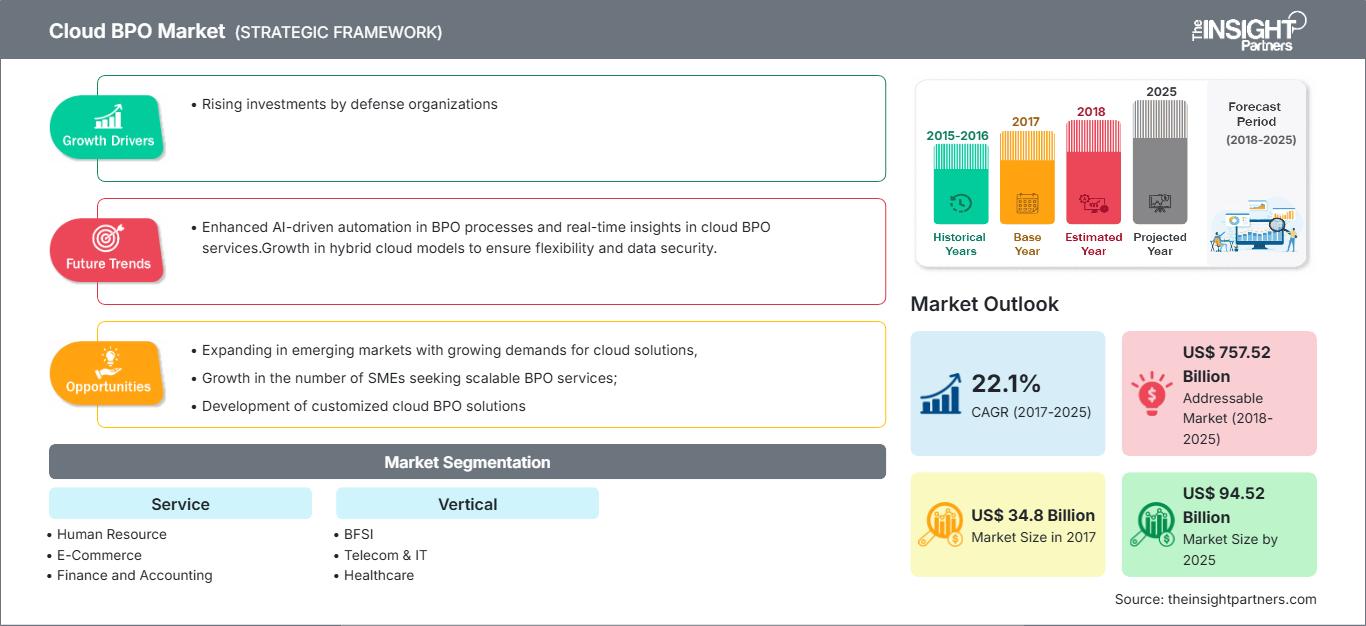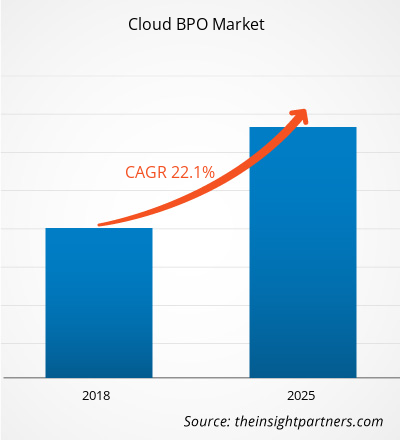Se estimó que el tamaño del mercado de BPO en la nube era de aproximadamente US$ 81.36 mil millones en 2025. Se proyecta que alcance alrededor de US$ 211.52 mil millones para 2034, registrando una CAGR del 11,2% durante el período 2026-2034.
Análisis del mercado de BPO en la nube
El pronóstico del mercado de BPO en la nube indica un fuerte crecimiento gracias a la adopción generalizada de la computación en la nube en los servicios de externalización de procesos de negocio (BPO), la reducción de costes operativos y la mayor agilidad, así como la capacidad de los modelos basados en la nube para gestionar flujos de trabajo a gran escala y con un uso intensivo de datos. El BPO en la nube permite a los proveedores de externalización reducir los costes de infraestructura de TI, acelerar el tiempo de procesamiento de datos y satisfacer las cambiantes demandas de los clientes con recursos flexibles en la nube.
Descripción general del mercado de BPO en la nube
La externalización de procesos de negocio en la nube (BPO en la nube) se refiere a la externalización de servicios de procesos de negocio (como recursos humanos, operaciones de comercio electrónico, finanzas y contabilidad, atención al cliente, ventas y marketing, y otros procesos de soporte) mediante infraestructura y plataformas en la nube, en lugar de los modelos tradicionales de externalización local o tradicional. Entre sus ventajas se incluyen la escalabilidad, la rentabilidad, la reducción de la carga de infraestructura y una respuesta más rápida para procesos con uso intensivo de datos.
A medida que las empresas migran cada vez más funciones comerciales a la nube y subcontratan a proveedores externos de BPO en la nube, el BPO en la nube se convierte en un facilitador clave para la transformación digital, la agilidad operativa y los modelos operativos globales.
Personalice este informe según sus necesidades
Obtendrá personalización en cualquier informe, sin cargo, incluidas partes de este informe o análisis a nivel de país, paquete de datos de Excel, así como también grandes ofertas y descuentos para empresas emergentes y universidades.
Mercado de BPO en la nube: Perspectivas estratégicas

-
Obtenga las principales tendencias clave del mercado de este informe.Esta muestra GRATUITA incluirá análisis de datos, desde tendencias del mercado hasta estimaciones y pronósticos.
Impulsores y oportunidades del mercado de BPO en la nube
Factores impulsores del mercado:
- Creciente demanda de ahorro de costos y agilidad en servicios subcontratados: la ventaja de costos que ofrecen los servicios de BPO en la nube (menor inversión en infraestructura, mayor escalabilidad) afecta significativamente la decisión de cambiar del BPO tradicional.
- Creciente adopción de la computación en la nube en todas las industrias: a medida que la computación en la nube se vuelve popular, los actores de BPO aprovechan la nube para gestionar procesos intensivos en datos y ofrecer tiempos de respuesta más rápidos.
- Necesidad de modelos de subcontratación flexibles y escalables: las organizaciones buscan socios de subcontratación que puedan ajustar la capacidad de forma dinámica, gestionar picos e integrar nuevos servicios rápidamente; el BPO basado en la nube respalda estos requisitos.
Oportunidades de mercado:
- Expansión hacia mercados emergentes con crecimiento de la subcontratación: regiones como Asia Pacífico, América Latina, Medio Oriente y África presentan potencial de crecimiento para los servicios de BPO en la nube, a medida que las empresas en estas regiones adoptan la nube y subcontratan funciones no esenciales.
- Integración de tecnologías avanzadas (IA, análisis) en ofertas de BPO en la nube: los proveedores de BPO en la nube pueden diferenciarse al incorporar análisis, automatización e IA en los servicios, mejorando así la eficiencia, la precisión y la propuesta de valor del proceso.
- Soluciones de BPO en la nube específicas para cada sector: ofrecer servicios de BPO en la nube personalizados para sectores industriales específicos (por ejemplo, BFSI, telecomunicaciones/TI, atención médica) presenta una oportunidad para abordar necesidades especializadas y requisitos de cumplimiento.
Análisis de segmentación del informe de mercado de BPO en la nube
Por servicio:
- Recursos humanos
- Comercio electrónico
- Finanzas y contabilidad
- Atención al cliente
- Ventas y marketing
Por Vertical:
- BFSI
- Telecomunicaciones y TI
- Cuidado de la salud
- Automotor
- Fabricación
- Alimentos y bebidas
- Poder y energía
- Electrónica de consumo
Por geografía:
- América del norte
- Europa
- Asia Pacífico
- Oriente Medio y África
- América del Sur y Central
Perspectivas regionales del mercado de BPO en la nube
Los analistas de The Insight Partners han explicado detalladamente las tendencias regionales y los factores que influyen en el mercado de BPO en la nube durante el período de pronóstico. Esta sección también analiza los segmentos y la geografía del mercado de BPO en la nube en Norteamérica, Europa, Asia Pacífico, Oriente Medio y África, y Sudamérica y Centroamérica.
Alcance del informe de mercado de BPO en la nube
| Atributo del informe | Detalles |
|---|---|
| Tamaño del mercado en 2025 | US$ 81.36 mil millones |
| Tamaño del mercado en 2034 | US$ 211.52 mil millones |
| CAGR global (2026-2034) | 11,2% |
| Datos históricos | 2021-2024 |
| Período de pronóstico | 2026-2034 |
| Segmentos cubiertos |
Por servicio
|
| Regiones y países cubiertos |
América del norte
|
| Líderes del mercado y perfiles de empresas clave |
|
Densidad de actores del mercado de BPO en la nube: comprensión de su impacto en la dinámica empresarial
El mercado de BPO en la nube está creciendo rápidamente, impulsado por la creciente demanda de los usuarios finales debido a factores como la evolución de las preferencias de los consumidores, los avances tecnológicos y un mayor conocimiento de los beneficios del producto. A medida que aumenta la demanda, las empresas amplían su oferta, innovan para satisfacer las necesidades de los consumidores y aprovechan las tendencias emergentes, lo que impulsa aún más el crecimiento del mercado.

- Obtenga una descripción general de los principales actores clave del mercado de BPO en la nube
Análisis de la cuota de mercado de BPO en la nube por geografía
América del norte
- Cuota de mercado: posee una porción significativa debido a una industria de subcontratación madura y una adopción temprana de la nube.
- Factores clave: gran base de contratos de subcontratación, alta adopción de infraestructura en la nube, demanda de servicios BPO rentables.
- Tendencias: Cambio a modelos BPO nativos de la nube, aprovechando la automatización y el análisis en los servicios BPO.
Europa
- Cuota de mercado: Participación sustancial debido a la fuerte tradición de subcontratación y al impulso regulatorio hacia los modelos de subcontratación digital.
- Factores clave: demanda de servicios de subcontratación basados en la nube que cumplan con las regulaciones de protección de datos (por ejemplo, GDPR), necesidad de modelos de subcontratación en varios países.
- Tendencias: Crecimiento de modelos BPO en nube nearshore, mayor adopción de BPO en nube por parte de empresas medianas.
Asia Pacífico
- Cuota de mercado: Región de más rápido crecimiento debido a la expansión de los mercados de subcontratación (India, Filipinas), la creciente adopción de la nube y las ventajas de costos.
- Factores clave: gran cantidad de proveedores de servicios BPO que migran a modelos de nube, crecimiento en la demanda de subcontratación empresarial e iniciativas gubernamentales que respaldan la infraestructura de nube.
- Tendencias: Creciente penetración del BPO en la nube entre las PYME, crecimiento de centros de BPO en la nube multilingües y con múltiples ubicaciones.
América del Sur y Central
- Cuota de mercado: región emergente para la adopción de BPO en la nube.
- Factores clave: demanda de soluciones de externalización rentables, crecimiento de clínicas privadas y centros especializados (en BPO de atención médica) y asociaciones público-privadas en externalización.
- Tendencias: Aumento de los centros BPO en la nube en América Latina que ofrecen servicios multilingües a América del Norte y Europa; crecimiento de la subcontratación de atención al cliente basada en la nube.
Oriente Medio y África
- Cuota de mercado: Mercado en desarrollo con un fuerte potencial de crecimiento para implementaciones de BPO en la nube.
- Factores clave: Estrategias nacionales de gobernanza electrónica, expansión de la industria de la subcontratación, desarrollo de infraestructura en la nube y centros de datos.
- Tendencias: Adopción de BPO en la nube para servicios administrativos del gobierno y del sector público, mayor demanda de subcontratación integrada con la nube y el análisis.
Densidad de actores del mercado de BPO en la nube: comprensión de su impacto en la dinámica empresarial
El mercado de BPO en la nube es altamente competitivo debido a la presencia de importantes proveedores globales de externalización e integradores de servicios en la nube, junto con actores regionales y de nicho. Este entorno impulsa a los proveedores a diferenciarse mediante:
- Integración perfecta de la infraestructura en la nube con los modelos de prestación de servicios BPO
- Ofertas de BPO en la nube escalables y rentables, adaptadas tanto a grandes empresas como a clientes del mercado medio.
- Uso de automatización, análisis e IA para mejorar la eficiencia, la precisión y los servicios de valor agregado de los procesos.
- Interoperabilidad con sistemas empresariales, cumplimiento de la seguridad de datos y capacidad de atender áreas de subcontratación en múltiples geografías.
Las principales empresas que operan en el mercado de BPO en la nube incluyen:
- Firstsource Solutions Ltd.
- WNS (Holdings) Ltd.
- Infosys Ltd.
- Tecnologías HCL Ltd.
- Genpact Ltd.
- Capgemini SE
- Atos SE
- Servicios de consultoría Tata Ltd.
- Accenture PLC
- Corporación IBM
Otras empresas analizadas durante el curso de la investigación:
- HP Inc. / Hewlett Packard Enterprise
- EXL Service Holdings, Inc.
- CGI Inc.
- Servicios globales de Sutherland, Inc.
- Tech Mahindra Limited
- Corporación Concentrix
- Teleperformance SE
- Wipro Limitada
- Corporación de soluciones tecnológicas Cognizant
- Fujitsu Ltd.
Noticias y desarrollos recientes
- La alta adopción de la computación en la nube en diferentes regiones está brindando oportunidades significativas para que los proveedores de servicios BPO en la nube aumenten su participación en el mercado.
- Las preocupaciones sobre la seguridad de los datos (violación de datos, inyección de malware, ransomware, denegación de servicio) siguen siendo un desafío clave a medida que se expande el BPO en la nube.
Cobertura del informe y entregables
El informe "Mercado de BPO en la nube: tamaño y pronóstico (2021-2034)" ofrece un análisis detallado que abarca:
- Tamaño y pronóstico del mercado de BPO en la nube a nivel global, regional y nacional para todos los segmentos clave del mercado cubiertos bajo el alcance
- Tendencias del mercado de BPO en la nube, así como dinámicas del mercado como impulsores, restricciones y oportunidades clave
- Análisis PEST y FODA detallado
- Análisis del mercado de BPO en la nube que cubre las tendencias clave del mercado, el marco global y regional, los principales actores, las regulaciones y los desarrollos recientes del mercado.
- Panorama de la industria y análisis de la competencia que abarca la concentración del mercado, análisis de mapas de calor, actores destacados y desarrollos recientes en el mercado de BPO en la nube.
- Perfiles detallados de empresas
- Análisis histórico (2 años), año base, pronóstico (7 años) con CAGR
- Análisis PEST y FODA
- Tamaño del mercado, valor/volumen: global, regional y nacional
- Industria y panorama competitivo
- Conjunto de datos de Excel
Informes recientes
Testimonios
Razón para comprar
- Toma de decisiones informada
- Comprensión de la dinámica del mercado
- Análisis competitivo
- Información sobre clientes
- Pronósticos del mercado
- Mitigación de riesgos
- Planificación estratégica
- Justificación de la inversión
- Identificación de mercados emergentes
- Mejora de las estrategias de marketing
- Impulso de la eficiencia operativa
- Alineación con las tendencias regulatorias






















 Obtenga una muestra gratuita para - Mercado de BPO en la nube
Obtenga una muestra gratuita para - Mercado de BPO en la nube